#and an extremely multicultural cast
Explore tagged Tumblr posts
Note
I really hope it doesn't sound like I'm trying to start an argument with this, I genuinely want your opinion. Do you think Israel should exist? Do you think it can exist peacefully? I'm a Jewish kid, I support Palestine and think the genocide needs to stop, but I feel like some (obviously not all) of the criticism of Israel feels a little bit antisemitic. Like I've seen people saying that zionists control a bunch of things internationally and in the us government, and that sounds very similar to antisemitic conspiracy theories. I'm sorry for asking you this, I just don't know who to ask. My mom is really sensitive about this because she's been bullied for being Jewish. And my friends aren't quite as politically aware, so they don't understand the history and just keep being like "why did the us ever support Israel to begin with?" and they certainly don't understand where zionism came from so I can't have actual conversations with them
So if you have anything to say, or any resources, anything you think I should read, that would seriously be really helpful
This ask contains several complicated questions so I'll break it down and do my best to present not just my opinion but also what I understand to be the context and the alternatives, and what factors shape my thinking.
Do I believe the state of Israel should exist? On one level, I don't believe any states should exist. All modern nation-states are built on some amount of violence and ethnostates especially all require some amount of erasure of groups outside the national group being enshrined in the national mythology. This is not unique to Israel; Atatürk's "One nation one language one flag" policy continues to be the basis of Turkish aggression against and denial of Kurdish cultural existence for example. The ongoing Tigrayan genocide is part of the legacy of Amharic supremacy in the statecraft that went into the building of the state of Ethiopia. Every nation-state has a dark history casting a long shadow. For more context on this topic, Worshipping Power by Peter Gelderloos is a good read.
As far as alternatives, the proposals of Murray Bookchin, what he calls Social Ecology, and the Democratic Confederalism proposed by Abdullah Öcalan are promising. Other historical examples of alternatives past and present include the Haudeosaunee Confederacy, the Caracol model of the Zapatistas, peasant cooperative experiments seen in Makhnovchina during the Russian revolution and in revolutionary Spain in the 30s, and of course the Democratic Confederalist experiment in northeastern Syria aka Rojava.
The Rojava model is especially relevant because, while westerners tend to make armchair pronouncements about what ought to happen in the Middle East based on extremely flawed and limited knowledge and a deeply ingrained cultural bias (read Orientalism by Edward Said for more on that), there are experiments in pluralistic multicultural democracy that originate from within the region that are much more relevant. It's always so wild to me to hear Zionist apologia in the form of the question, "well what else could we ("we?") possibly support if not a two-state solution or an only-Israel 'the only democracy in the Middle East™️' solution?" When practically right next door there is a thriving 10-year experiment in radical democracy in an area with more ethnic, religious, and language groups than you can count on one hand, in an area where some people from those groups were brutally murdering each other less than a decade ago and now are having to find ways to patch up society and function in peace and with respect and self-determination for all groups there. That seems very relevant as an example but I almost never hear anyone mention it and Palestine together, despite historically the movements supporting each other.
As far as antisemitic conspiracy theories, I think you're right about that. I know a lot of people, even well-meaning people who have not fully examined their internalized antisemitism, will talk about US support for Israel as if Israel is controlling US politics and that is why there is so much military aid being sent, or they will talk about American support for Israel as if it's the result of Jewish influence in politics. On no other topic do Jews hold this amount of sway. Jews tend to support immigration reform and universal healthcare and yet we don't have the power as a tiny voting bloc to get those passed. No, the US supports Israel because it's an investment. Israel is essentially a weapons research and development laboratory for the US. The Israeli economy is overwhelmingly dependent on its military development and exports. A good source for this is the documentary film, "The Lab" directed by Yotam Feldman, an Israeli Jew himself, who goes into great detail on the role that Israel plays in weapons development for not only the US but also dictatorships in South America.
The other big source of American support for Israel is based on religion but not the Jewish religion. Evangelical Christians are by far the most powerful religious group in US politics, and they believe that Jews being returned to the holy land is a necessary component of triggering the war of Armageddon and bringing about end times etc. They are not our friends; our role in their teleology is to die to bring about the salvation of (a relatively small number of) Christians. This group is represented by powerful televangelists like John Hagee, whose organization Christians United For Israel describes itself as America's largest pro-Israel group. Not only are not all Jews Zionists and not all Zionists Jews; there are more Christian Zionists in America (30 million according to Tristan Sturm) than there are Jews in the entire world (less than 17 million according to Sheskin and Dashefsky data for 2023.)
Antisemitism absolutely still exists and is a real problem, and the conflation of critique of Israel with antisemitism makes genuine antisemitism much harder to address. Israeli propaganda deliberately inflames the reasonable and justified fears of Jewish people and directs them at a relatively powerless target rather than at the systems that endanger all of us.
I would argue that the state of Israel itself is antisemitic. Not only does it aggressively promote the old antisemitic narrative that conflates Jewish identity with Zionism, it has been instrumental in the displacement and destruction of so many Jewish communities and traditions that had been existing for centuries. I just finished reading My Father's Paradise, by a Kurdish Jew whose father's family was forced to relocate to Israel shortly after his bar mitzvah, the last ever to happen in the ancient Aramaic-speaking Jewish community of Zaxo in northern Iraq. It captures a poignant glimpse of how it feels to be the last surviving native speaker of your childhood language, and the role Israeli statecraft played in dooming many Jewish communities of the diaspora to that fate.
And here's maybe my hottest take: even if there were no genocide of Palestinians to worry about, I would still be anti-Zionist because I think Zionism is inherently anti-Jewish. Most of Jewish life has happened in the diaspora for the last several millennia, yet Zionism is an anti-diaspora ideology that sees our lives, our homes, our diverse sub-cultures and languages and spiritual practices as inferior, broken, not worth preserving let alone continuing. Modern Zionism is, by Hertzl's own admission, a settler-colonial project intended to shape Jewry into the mold popular among European nations at the time, and thereby win the respect of Christendom by playing their game on their terms and excelling. In short The national project of Israel is manufacturing whiteness for Jews.
But the truth is that for as long as there has been political Zionism, there have been Jewish anti-Zionists, as evidenced by folk songs like the century-old "Oy Ir Narishe Tsionisten" ("Oh You Foolish Zionists") re-popularized by Daniel Kahn, whose music is also associated with a Yiddish cultural revival among young diaspora Jews.
There's a lot more I could ramble on about and more books I could point towards but this is already very long and I'm no expert on the subject, just a very tired Jew who has been at this for a long time now. I'll leave you with a link to a good article about the recent wave of campus protests and incidents of alleged, and sometimes actual, antisemitism among them:
#antisemitism#jews#campus protests#jewish#antisemitism on campus#antizionism#you can also be anti zionist for reasons that are completely separate from palestine#palestine#google murray bookchin#support rojava#rojava#middle east#google abdullah öcalan
24 notes
·
View notes
Text




Can the Bay Area be TV/film's next big creative incubator? Native Rafael Casal is betting on it.
Despite sharing a state with Hollywood, despite having been the source and setting for many incredible films, the Bay Area has never really been known as a center of movie and television production. A new initiative by writer, producer, actor, and poet Rafael Casal hopes to change that perception.
The Bay List, a collaboration between Casal and producer/entrepreneur Franklin Leonard, will identify and highlight exceptional screenplays and television pilots by writers from, or with close ties to, the Bay Area. Along with a cast of high-profile partners, The Bay List will select the 10 most promising projects submitted by writers between now and April 2025, then work with them to amplify their ideas and secure educational and production opportunities.
“I think because of the multiculturalism of the Bay, the often extreme economic inequality, the diversity in our public schools, the progressive imagination of the community members, the corruption in government and policing, the multi-hyphenate nature of our self-sustaining art scenes, and on and on and on, and up and down, that powder keg has created an environment that produces some of the world's most impressive thought leaders,” says Casal. ”I have a strong feeling that if making movies and TV felt more obtainable to artists in the Bay, we would see a true renaissance of film explode from here.”
Indeed, that “powder keg” has already resulted in some unforgettable pictures, including some that Casal is especially fond of, like the documentary The Force (2017) by Pete Nicks, which captures the depths of police violence and corruption in the Bay Area, and the 1979 classic Escape from Alcatraz starring Clint Eastwood. “La Mission (2009) by the Bratt brothers is a beautiful film [that] captures the Mission District pre-gentrification, a place that now feels like a fantasy,” says Casal. “The [Latine] community in the Bay is not often depicted on screen, and Northern California feels so different than L.A in that respect.”
Big and small, Casal tries to watch all of the productions connected to the Bay Area—and there are still infinite stories to be told. The idea to bring more equity and access to those telling them was inspired by Leonard’s pioneering project The Black List, which has a similar goal in helping overlooked scripts get noticed. Initially founded in 2005 to survey the most-liked screenplays that remained unproduced each year, the initiative has grown into a virtual marketplace democratizing access to the film industry for writers from more than 100 countries.
“The Black List has been a fantastic resource for screenwriters for quite some time now, but I have to admit that it wasn't until after I made my first film that I heard about it,” explains Casal, who wrote, produced, and starred in 2018’s Blindspotting and its 2021 Starz spinoff with childhood friend Daveed Diggs. “The Bay List is my attempt to partner with Franklin and his team to bring awareness about The Black List to the Bay, creating a specific list just for us. The hope is that collaborations are formed through this process, which can help bridge the gap between the Bay Area writing scene and the Hollywood machine of actually getting things made.”
Even in its inaugural year, The Bay List has already secured the participation of some of the region’s biggest names in entertainment: Lucasfilm (the San Rafael production company founded by George Lucas), Playtone (the production company founded by Alameda-native Tom Hanks), Unanimous Media (founded by Steph Curry and Erick Peyton), Who Knows Best Productions (founded by W. Kamau Bell and Melissa Hudson Bell), and almost a dozen others altogether. They��ll be involved in selecting the first cohort of finalists and in providing them with various forms of support such as pitching workshops, public table reads, and business development guidance.
“This project lives and dies by the generosity and time of some of the Bay Area’s most major players, and I am so grateful that they even entertained the idea,” says Casal. “The truth is, we need to make a big splash to get folks to pay attention, and so on the front end just lending their names is incredible—but even more valuable, are some of the resources each of them have pledged to the top 10 finalists.”
The only requirement to submit a film or television script is that the writer was born in, grew up in, or currently resides in one of the Bay Area’s nine counties full- or part-time. Those who lived here for a significant period as children or adults are also eligible, and screenplays and pilots don’t need to focus on the region to qualify. The Bay List will announce its shortlist in May 2025 and declare 10 finalists in July.
“The Bay is unique in the world. There is something in the water,” says Casal. “As someone who believes art pushes a society forward, I would hate to leave that stone unturned. I'm from under that stone.”
5 notes
·
View notes
Text
ELLE Exclusive: Mile And Apo Chat About Their Upcoming Movie Man Suang
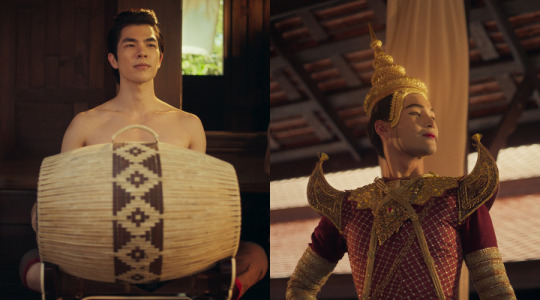
ELLE: Did you expect such long queues of fans awaiting you in India?
Mile & Apo (M & A): India was always on our bucket list to visit and explore, all thanks to its rich culture and diversity. And when it comes to the fans, we actually did have an idea of our Indian fanbase because our tags are always filled with their appreciative posts. But such a huge welcome was totally unexpected! The moment we saw fans waiting for us at the airport, we were ecstatic, to say the least.
ELLE: How did you embody your new characters in Man Suang?
Apo: We had several workshops with the director to get into the characters, as we had to go back in time to represent them. I also gave myself a lot of time to master this traditional Thai dance; its glimpse can be seen in the trailer, and it is now one of my favourite takeaways from the shoot.
Mile: I studied the way people used to live back in that time period because there were very rare representations of that time in movies or series for us. I researched the politics of this era, as well as the migration or export and import of culture, as multicultural representation is a big part of my character. I also learned to play some traditional musical instruments which is something new for me.
ELLE: Describe your characters’ roles in the film.
Apo: My character’s name is Khem; he is like an underdog in that era’s social scenario. He has this aspiration to climb the social ladder. Khem is a layperson who’s from a slave community. So to go above and beyond in this social drama, he uses traditional Thai dance. And as we know, Man Suang is a place for entertainment for up-per-class people. This is where anyone can be anything they want without being judged. And this is a mystery for him because this place is where class barriers are broken.
Mile: I play this character called Khun Chat, whom I would describe as a very sorted and defined man with a clear goal and a vivid mission, and he’s really true to him-self and his goal. Since day one, he’s the same person, and this is portrayed through the beauty and aesthetic of the movie. And along the journey, you will see the layers of his thoughts and character develop.
ELLE: What makes Man Suang different from other mystery or suspense films made in Thailand?
Apo: For me, it is the uniqueness of the story, which showcases an extremely different era, as well as the different sexuality of the characters, which will come to life through this set of hardworking actors. It’s not the typical static movie; this one is round and dynamic. There is a much-needed grey area in everyone’s character; nobody’s too good or too bad, which will be seen in a very organic way for the plot development.
Mile: The biggest key is the naturalness of each character, and that brings charm to the story. Man Suang has a cast that plays these diverse characters, and the plot itself deals with numerous issues that have some complexity, be it through the music, the suspense of the story, or the aesthetics.
ELLE: Which was your favourite scene to shoot for the film?
M & A: The shoot was overall a very different experience for both of us. And when it comes to our favourite shot or scene, we will surely say it has to be our emotional scenes because that’s where we feel more connected to our characters. And we expect that’s where the audience will see our characters in a different light as well.
ELLE: Will Man Suang release in India?
M & A: That is something we are surely hoping for. No matter which channels people can watch it on, we would love it to reach a global audience because its story is a mixture of cultures–whether it’s Thai, Chinese or even Indian. One of the biggest reasons for making this movie is to showcase our Thai culture to an international audience.
62 notes
·
View notes
Text
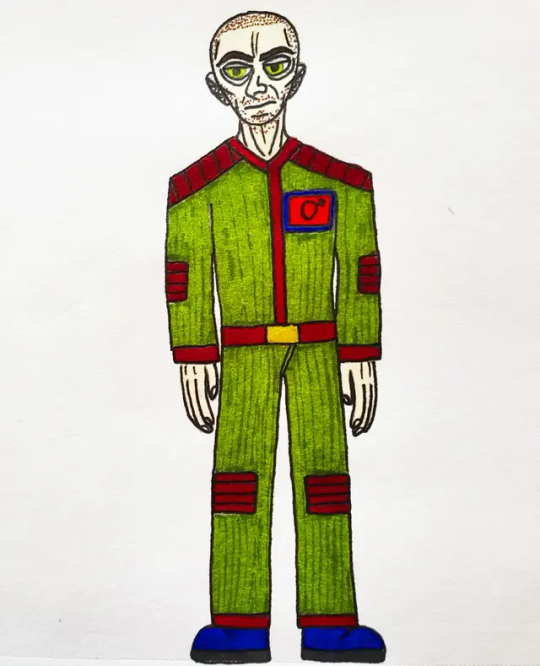
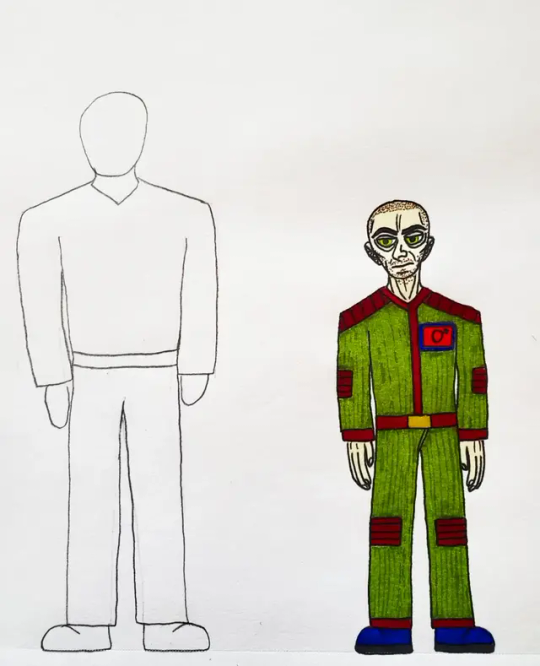
Martian Humans were discovered on the planet Mars, contacted in the year 3990. These creatures are the genetically modified descendants of Humans, who found that it was impossible to gestate healthy offspring under the natural gravity of the planet. Without planetary gravity manipulation technology, their best bet for creating somewhat healthy descendants on the planet was through genetic engineering, selecting for genes that would give them denser muscle and bone tissue to keep them durable enough to perform hard labor, larger hearts to more effectively pump blood throughout their bodies, and shorter stature to curtail risk of malnutrition and allow them to function more efficiently in the small enclosed spaces of spaceships and Martian habitat bases. This full scale colonization of the desolate planet occurred in response to a “white identity crisis” experienced by many pale-skinned humans as a reaction to growing ethnic diversity across earth. After a disastrous “race war” movement manifested across the globe, white purity elites formed political groups focused on establishing a white homeland on Martian soil, mounting expeditions to the red planet where they waged war on and enslaved the prisoner population of preexisting Martian penal colonies, creating a caste system to enforce the institution. This produced the all white generation of genetically modified Martian offspring that took control of the planet, breeding in great numbers and using their inherited institution of slavery to great effect, expanding mining and plantation operations wider than ever before seen on the planet. Using the massive quantities of uranium formed in the planet’s crust from millennia of radiation bombardment, Martians built the largest nuclear stockpile ever seen in human history. The Martian ethnostate recognized itself as a more “highly evolved” form of “Terran” humanity, considering themselves “Homo sapiens martius” despite all scientific evidence pointing to the fact that they are not genetically distinct enough to be considered a subspecies. The severely limited genetic diversity of Martians led to a bottleneck effect, and eventually inbreeding. Assimilation into the Ecosystem did not go smoothly, put in a few words. There was debate whether or not to exterminate the entire Martian population due to the risk they posed of spreading slavery across the universe and the fact that standard Terran Humans had already joined the collective, but it was decided that this was too extreme and would set a dangerous precedent, so the assimilation process went as usual, ending with the Raid phase dissolving all Martian governmental bodies by force. The Martians were infuriated by this swift defeat but recognized the importance of preserving their species' existence on their homeland and didn't push further. Upon introduction to the Ecosystem, they were disgusted by its multicultural assortment of alien life living alongside one another and mostly kept to themselves, still adorned in their traditional military garb and confident in their slogan that “Father Mars Shall Rise Again”. For decades, several slave states established by Martians on Ecosystem worlds have been broken up, routinely putting the continued preservation of these people's core society into question.
#the ecosystem#martians#speculative physiology#speculative genetics#speculative biology#art#illustration#science fiction#character design#speculative fiction#speculative history#future#alt history#alternative history#humans#genetically modified human#genetically modified humans#genetically modified#scifi
3 notes
·
View notes
Text
Zack Beauchamp at Vox:
“Are we a country that looks out for each other ... or do you go down a path of amplifying anger, division and fear?”
That’s how Canadian Prime Minister Justin Trudeau described the stakes in his country’s upcoming election in an interview with Vox’s Today, Explained this week — outlining the 2025 contest as no ordinary election but a referendum on the very soul of Canada. This existential framing is an unsubtle shot at Trudeau’s rival, Conservative Party leader Pierre Poilievre, a populist firebrand who is currently outpolling the prime minister by a wide margin. Poilievre rose to party leadership as a champion of the extremist trucker convoy that occupied Ottawa in January 2022, and since then has regularly pandered to far-right voters. He has proposed defunding the CBC (Canada’s widely respected public broadcaster) and repeatedly promoted a conspiracy theory in which Trudeau is in league with the World Economic Forum. There’s a reason that Trudeau and many others have directly linked Poilievre to Trump: His political style practically invites it. But how accurate is the comparison? Is Canada really poised to be the next Western country to fall to the far-right populist global wave? The answer, as best as I can tell, is mixed.
It’s true that, by Canadian standards, Poilievre is an especially hard-nosed figure, one far more willing to use extreme rhetoric and attack political opponents in harsh terms. But on policy substance, he’s actually considerably more moderate than Trump or European radicals. Mostly eschewing the demagogic focus on culture and immigration that defines the new global far right, Poilievre is primarily concerned with classic conservative themes of limited government. His biggest campaign promises at present aren’t slashing immigration rates or cracking down on crime, but building more housing and repealing Canada’s carbon tax. Poilievre is basically just a conventional Canadian conservative who wraps up his elite-friendly agenda in anti-elite language aimed at working-class voters. He’s the kind of politician that some Republicans wish Donald Trump was: a tame populist. Understanding Poilievre isn’t just of interest to Canadians. There are reasons that his brand of populism is less virulent than what’s cropped up in many other Atlantic democracies — ones that hold important lessons for safeguarding democracy around the world.
Why Pierre Poilievre doesn’t fit the far-right script
The University of Georgia’s Cas Mudde, one of the leading scholars of the European right, has developed what is (to my mind) the most useful definition of radical right politics today. In his account, this party family — factions like Hungary’s Fidesz, France’s National Rally, and the US GOP — share three essential qualities. First, they are nativist; they strongly oppose immigration and multiculturalism. Second, they are willing to use aggressive, even authoritarian measures to deal with social disorder like undocumented migration and crime. Finally, they are populist, meaning that they define politics as a struggle between a virtuous people and a corrupt elite. Poilievre is certainly a populist. A right-wing operative and politician since he was a teenager, he rocketed to the top of the Conservative Party hierarchy after emerging as the most vocal champion of the 2022 Ottawa occupation. The uprising, which began against pandemic restrictions but swiftly became a broader far-right movement, was quite unpopular nationally. But inside the Conservative Party, there was enough support for its “pro-freedom” message that Poilievre rode his pro-convoy stance to victory in the party’s subsequent leadership election.
Since then, his populism has focused relentlessly on attacking the media, “globalists,” and (above all) Trudeau. Casting the fight between his Conservatives and Trudeau’s Liberals as the “have-nots” versus the “have-yachts,” he has argued that the prime minister embodies a debased Ottawa establishment out of touch with the needs and values of ordinary Canadians. In a recent speech, Poilievre cast Trudeau as an “elitist” leader gunning for Canada’s freedoms. “If he had read Nineteen Eighty-Four, he would have thought it was an instruction manual,” Poilievre argued. Somewhat ironically, Poilievre also believes Canada’s criminal justice system should be harsher. Blaming Trudeau for a recent rise in car thefts, Poilievre has argued for a reimposition of mandatory minimum sentences and other tough-on-crime policies. This means there’s at least a case that he also fits the second prong of Mudde’s definition of radical right politics. But on the first prong, nativism, Poilievre clearly diverges from Trump and the European far right. He has publicly insisted that “the Conservative party is pro-immigration,” and he has made appealing directly to immigrants a central part of his campaign strategy.
[...] Arising primarily in Western provinces (Manitoba, Saskatchewan, and Poilievre’s native Alberta), Canadian “prairie populism” historically draws strength from the notion that the federal government cares more about the population centers in Quebec and Ontario than the rest of the country. Prairie populism, which comes in left- and right-wing varieties, focuses far more on regional and economic issues than the cultural obsessions of the modern far right. “We have had a long history of populism — particularly in the prairie provinces, the Western provinces — going back to the 1920s and 30s,” says Keith Banting, a professor at Queen’s University in Ontario. “Populism draws less extensively on anti-immigrant sentiment in Canada than it does almost anywhere else.” Indeed, Poilievre’s biggest focus is cost-of-living issues — blaming ordinary people’s economic pain on high taxes and big government. His signature proposals are repealing Trudeau’s carbon tax, cutting spending to fight inflation, and removing restrictions on housing construction.
[...]
Poilievre’s “plutocratic populism”
While Poilievre is a very Canadian figure, fitting solidly into the right-wing prairie populist tradition, his politics also have a lot in common with a concept developed for the United States: political scientists Jacob Hacker and Paul Pierson’s “plutocratic populism.” In their book Let Them Eat Tweets, Hacker and Pierson argue that the Republican Party uses culture war as a vehicle to attract popular support for a party that primarily caters to the interests of the rich. This strategy of “exploiting white identity to defend wealth inequality” allowed Trump’s GOP to attract downscale, non-college-educated voters without abandoning its core commitment to tax cuts and deregulation.
But in the United States, the populists ate the plutocrats. Trump’s anti-democratic instability and economic heterodoxy on issues like trade led some GOP billionaires, like the Koch family, to try and unseat him in the 2024 primary. They failed miserably and now are slinking back. In the Republican Party, MAGA is calling the shots. Poilievre, by contrast, keeps his populism within plutocrat-acceptable bounds. His rhetorical gestures toward the working class are paired with solidly pro-rich policy views and a distinct absence of attacks on the democratic system itself. In 2013, he claimed to be “the first federal politician to make a dedicated push” toward imposing US-style right-to-work laws in Canada. He has endorsed tax cuts for the rich and cuts to social spending. His trade policy is far more free-market than Trump’s. There are no signs that he would challenge the legitimacy of Canadian elections, let alone stage a January 6-style insurrection.
Vox reports on Conservative Party of Canada leader Pierre Poilievre's brand of right-wing populism is tamer than Donald Trump, Viktor Orbán, or Marine Le Pen's.
5 notes
·
View notes
Text
Movie Review | Vigilante (Lustig, 1982)
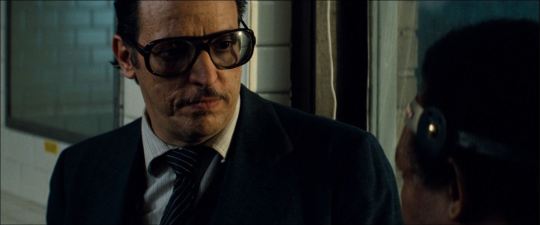
This review contains spoilers.
Given the premise, this obviously invites comparisons to the Death Wish series, and plays in some respects like a supercharged amalgamation of the first two. You get the hero's family being attacked by a multicultural gang with cute matching outfits, his wife being brutalized and his son being killed. This is a gruesome and horrific scene, but perhaps easier to watch than in those other movies because it seems less eager to revel in sexual assault. You get the hero, who was previously against vigilantism, eventually warming up to it after the law lets him down. We already know he's in for a bad trip when the DA, who's supposed to be prosecuting the case, basically admits defeat against the violent crime problem by citing a bunch of bullshit statistics. (To paraphrase a very wise man, you can come up with statistics to prove anything. Forty percent of all people know that.)
But it isn't just that the courts fail to sufficiently punish the gang member accused of the crimes against his family. Thanks to the smug liberal judge assigned to the case and the DA revealing her talent for being the world's worst negotiator, not only does the gang member get carted back to the streets after his murder charge is dropped and his assault charge gets a suspended sentence, but the hero gets thirty days for objecting to this gross miscarriage of justice. The depiction is so over the top that if you squint enough, you can read the movie as a satire of the vigilante thriller genre. Early on, the hero questions what would separate him from the bad guys if he started taking the law into his own hands and at one point he would go too far, and the movie practically answers that at the end by having him blow up the judge who bungled his case. It's almost as if the movie wants to demonstrate in the most extreme terms what it would look like if you took the vigilante ethos to its logical end point. To say the ending left me uneasy is to put it lightly, but it's undeniably forceful.
This is a better movie than Death Wish and its sequels (full disclosure: I haven't seen the fifth) because William Lustig is a much better director than Michael Winner, and for whatever questionable ideas the movie pushes or interrogates about its subject matter, it treats the proceedings with a dramatic sensitivity mostly absent from the other series after the original. It helps that Lustig is working with a tremendous cast, with an effortlessly sympathetic and wounded Robert Forster in the lead, and supporting players like Fred Williamson and Woody Strode lending charismatic voices to the movie's ideas. But most fun is Joe Spinell as a sleazy lawyer, who is known for playing deranged, sweaty maniacs but is also entertaining when playing slimy fast talkers, and who steals the movie in his couple of scenes as he maneuvers to get his defendant off lightly while threatening him with "Legal Aid" when the gang tries to stiff him on his fee.
And the gulf is wide on a technical level too. Winner is the furthest thing from a polished craftsman, although the crudeness of Death Wish 3 does give it a nicely unhinged quality, the action contained within playing as a series of pure violent reflexes, one goon killed after another in the cinematic equivalent of a nervous twitch. But while Lustig sets his movie in a crumbling pre-cleanup New York, he gives it a palpable sense of mood as she shoots it in chilly blue widescreen cinematography and scores it with grimy synths to boot. And the grim, two-fisted violence is lent an added charge by the surprisingly elegant cutting, closeups of a cracked family photo frame after the attack on Forster's family, and closeups to Forster's scowling face as he metes out his revenge.
I'd been itching for a rewatch since I missed the chance to see it in theatres a few months ago (a combination of dreadful winter weather and having fallen ill at an inopportune time), and was very pleased to revisit it and find that it rocks even harder than I remembered.
6 notes
·
View notes
Photo
I feel like posting that there are depictions of Jesus where he isn't white as if it's like PROBLEM SOLVED, EARTHA KITT! is kind of missing the point. Gee whiz!!! I wonder what was in recent memory to someone like her back when this was filmed!!!
People in the USA are conditioned towards "White = Good" in media, including religious media. And if anything, religious media is more ingrained. Not that many people go "Evangelical canon is so weak this season, I'm gonna catch up on some Buddhism."
People tried to stir up dumb culture war crap over Black Santa.
Media companies have a long history of saying that majority non-white casts are "not gonna sell."
A portion of society is extremely stressed out by the concept of the USA becoming Minority Majority. The USA is at like 57-60% white people at this point.
People are constantly claiming every society was historically 100% homogeneous in the name of racist nationalism. A lot of times things seem racially homogeneous because someone has put a very vested effort into that! A neighborhood being almost 100% white rich people is rarely something that started by accident. People will claim nonwhite people living in a neighborhood "brings the property values down." There are tons of dumb zoning laws that are attempts to keep poor and nonwhite people out. HOAs are often a method to harass people that the ones in charge don't like until they leave the neighborhood.
People who think Heaven shouldn't be multicultural.... is like hmmmm so that is what you think the Perfect Place is... Religion and racism working hand in hand is nothing new.
And I'm always more than a little suspicious about people who tell non-white people to go look at non-USA media when an USAmerican is discussing representation. Like it happens literally every time Asian-American representation is discussed and some racist who thinks he's very smart goes "but people in Japan and China don't care about this!"
In racists' eyes, the USA doesn't need to change, those brown people just need to go back where they came from or huddle only with their own race where white people don't have to see them.
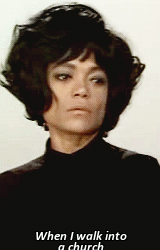
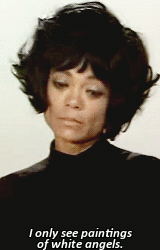

523K notes
·
View notes
Text
#1 Intro
youtube
0:38- 1:40
“‘crazy Rich Asians’ Cast on the Film’s Impact on Representation in Hollywood | Today.” YouTube, YouTube, 15 Aug. 2018, www.youtube.com/watch?v=X4wrvjOfaWs.
Sugino, Corinne. “Corinne Mitsuye Sugino, ‘Multicultural Redemption: Crazy Rich Asians and the Politics of Representation.’” Lateral, 2 June 2022, csalateral.org/issue/8-2/multicultural-redemption-crazy-rich-asians-politics-representation-sugino/.
As you can tell from this clip from the Today Show, #CrazyRichAsians celebrates Asian culture and identity. Although the movie continues to reinforce classist stereotypes through its exaggerated depiction of extreme wealth and insane consumption among Singapore's elite, it completely skips over issues of economic inequality and class divides. This was the first film in 25 years that was an all Asian cast which was a very big deal for the Asian community. Is this really to be celebrated? #CrazyRichAsians not only brought Asian faces onto the Hollywood scene but developed their characters outside of tired racial stereotypes, e.g. Yunioshi from Breakfast at Tiffany’s who was played by a white actor in yellowface makeup to be a mimicry of a Japanese man. Historically speaking, mainstream representations of Asians have been undermined, model minority stereotypes, yellowface, and other stereotypical depictions. Some articles critique the continuous celebration of excessive wealth and for limiting its representations to East Asians while excluding Southeast Asians. Scholars have agreed with the statement as well. Not to mention that the entirety of the romantic plotline reinforces that class division exists rather than challenging class division.
0 notes
Text
Directing DRAINING THE SWAMP
ON TOUR IN MARCH/APRIL
A New play about British fascist leader Oswald Mosley...
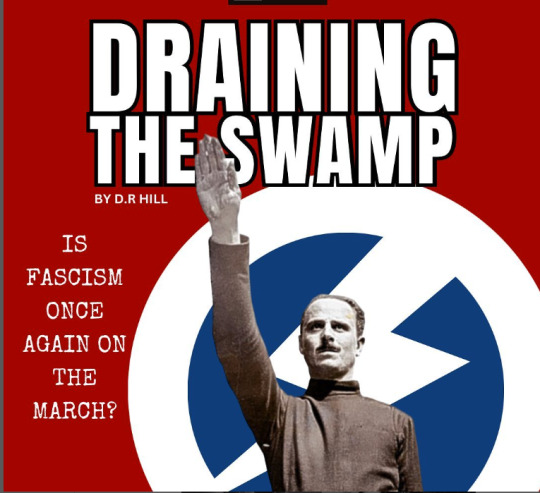
What lessons are there for today when nationalism is once more on the rise across the Western world, and politicians like Trump and many more worlwide, are able to attack democracy and stir up violent protest? Draining the Swamp is a provocative new play, exploring these issues and challenging our approach to extremism. It raises questions and warns with a chilling contemporary punch. A Thought provoking and challenging new play.
"An incisive exploration of the rise of fascism"
⭐⭐⭐⭐⭐ Counter Culture UK
"A first class piece of historical theatre"
⭐⭐⭐⭐ One4review
DRH productions present a new play by David Hill, directed by Exchange Theatre's artistic director David Furlong (MISANTHROPE, THE FLIES).
DRAINING THE SWAMP
Oswald Mosley was considered to be the most able politician of the 1920s, a Labour Prime Minister in-waiting. What caused a changed direction for this man, who then founded the right-wing British Union of Fascists, renowned for street violence and antisemitism?
Meet Sir Oswald and Lady Diana Mosley who were given a short, sharp portrait in the BBC Peaky Blinders series. Exploring the life and activities of the Fascist leader, from the 1930's to 1960's, discover the private personas behind the Fascist leader and his unorthodox wife, both vilified and adored in their lifetimes.
Was he the thuggish villain he is portrayed as? Was he deluded, dangerous or visionary? How critical was Diana's supporting role? Draining the Swamp unpicks the intentions behind the dangerous and controversial activities that Mosley led, inviting judgement about his legacy, and raising questions about parallels with contemporary British and American politicians. What is the democratic solution to managing politicians like Mosley today?
A play by David R Hill Directed by David Furlong Videos and design by Jeffrey Choy https://www.jchoy.co.uk/
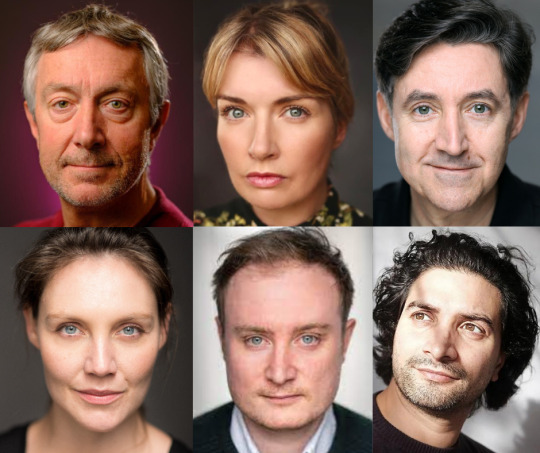
CAST:
Rowland Hill as Oswald Mosley
Ciara Pouncett as Lady Diana Mosley
David Boyle as Lord Curzon & David Frost
Claudia Whitby-Tillott as Cimmie Mosley and Alexandra Curzon
Chris Keyna as Jeffrey Hamm

TOUR DATES and Booking Links:
OSO, Barnes, London, 29 Feb – 2 March (Thur – Sat)
Beccles, Wed 6 March
Dorchester Arts (Dorset), Thurs 7 March
Cornerstone, Didcot, Wed 17 April
Swindon Arts centre, Fri 19 April,
Oxford Playhouse, Sat 20 April
Brentwood Theatre, Wed 24 April
Stables, Hastings, Thurs 25 April
#Theatre #Drama #performance #actors #actorslife #actorslife #acting #stage #picoftheday #play #london #london #londres #londres #theatreinlondon #theatre #ukactor #ukactors #backstage #backstagelife #multicultural #diversity #multilinguism #stageactor #workingactor #oswaldmosley
0 notes
Text
Exploring Indian American Matchmaking: Trends and Traditions
Comprehending Indian American Matrimony
Finding a life mate often requires Indian Americans to strike a careful balance between their traditional values and contemporary goals. Indian matchmaking frequently lays more emphasis on community ties and familial engagement than does the Western dating idea, which prioritizes individual autonomy and choice. Parents, siblings, and even family friends actively participate in recommending possible mates, taking into account important factors including socioeconomic class, caste, religion, and common backgrounds.
Matchmaking takes on a distinct flavor in the USA, where Indian Americans make up a vibrant and diversified population dispersed throughout the nation. It turns into a tool for managing the challenges of living in a mixed society while protecting cultural heritage. Indian American matchmaking is as varied as the society it serves, ranging from small, private get-togethers within tight-knit groups to major marital festivities that unite families from many states.

The Development of Indian Dating in the United States Technology and shifting social mores have driven a transition in Indian matchmaking in the USA throughout time. The rise in popularity of dating websites and apps has provided a practical substitute for conventional approaches, enabling people to choose from a larger pool of possible mates.
The increasing acceptance of intercultural unions and partnerships among Indian Americans is one of the main forces underlying this change. Younger generations are increasingly receptive to establishing relationships beyond boundaries of caste and geography as they embrace multiculturalism and globalization. The Indian matchmaking scene has changed as a result of this shift towards openness, opening doors for varied pairings and cross-cultural interactions.
Indian Dating Sites: Uniting Societies and Traditions The function of indian matchmaking websites, which act as virtual gathering places for people looking for compatible companions, is central to Indian American matchmaking. In order to make the process of finding a partner easier, these platforms provide a number of features. These include customized profiles, compatibility algorithms, and sophisticated search filters that take into account factors like lifestyle, occupation, and education.
Matchmaking websites have the benefit of being able to connect Indian Americans from different states and even nations by overcoming geographical constraints. These websites offer a forum for connection and exploration, regardless of whether you’re a second-generation immigrant negotiating your cultural identity or a recent arrival to the USA looking for companionship within the Indian community.
Obstacles and Things to Think About Indian dating services present a positive way to meet people and find love, but they are not without difficulties. Finding a balance between tradition and modernity is one of these challenges. Different expectations and tensions between generations might result from people prioritizing different things. For example, some people may favor shared values and cultural compatibility, while others may prefer emotional connection and personal compatibility.
The existence of prejudices and stereotypes in the matching process presents another difficulty. Making their way through ingrained stereotypes of success and attractiveness as well as unconscious prejudices based on skin tone or caste can be extremely difficult for people looking for real connections. Moreover, the matchmaking process may become even more complicated due to the pressure to live up to family and society expectations.

In summary, Indian American matching occupies a special place in American culture by merging creativity and tradition with individualism and community. It is critical to acknowledge the various experiences and viewpoints that influence the matchmaking process as the landscape changes. Indian American matchmaking will live on as a celebration of culture, connection, and the never-ending search for love as long as it fosters communication, understanding, and respect for one another.
Every thread in the indian american matchmaking tapestry symbolizes a journey, a tale, and a common need for belonging and connection. Let’s treasure the customs that unite us while welcoming the diversity that enhances our shared experience as we negotiate the challenges of contemporary life. In the end, discovering oneself on the path to love, fulfillment, and belonging is more important than just finding a match.
0 notes
Text
I have a strange project idea. I don’t know if I’m gonna achieve anything with it… I don’t think it has a purpose save for passion.
I’m really feeling the nostalgia of Persona 4. And I think just because the person who introduced it to me lived on the outskirts of Vancouver, and a lot of supernatural murder mystery has a like… Twin Peaks inspired vibe, and since I haven’t officially seen Twin Peaks, just a shit tonne of stuff inspired by Twin Peaks, my brain is like “damn I don’t know if this is has Twin Peaks vibes or is just a supernatural murder mystery…” and since Twin Peaks was extremely popular, and had a big fan base in Japan, I fully have no idea how many anime and Japanese games have Lynchian vibes on purpose.
Or picked them up second hand like me. Did we accidentally grab them from Silent Hill and Alan Wake and Life is Strange and now despite limited exposure to the man’s actual filmography we’re deeply influenced by David Lynch?
Anyway, firstly, I have decided since I’m trying to practice drawing again to get back in the habit I’m gonna do a fan project where I combine Persona 4 and Life is Strange. Basically because Persona 4 gives me The Vibes.
So reimagining it like it takes place in a small town outside of like… Vancouver. Like the friend that recommended the game, and the nostalgic place that also broke my heart because it’s also where my first girlfriend lived. So a bunch of like… you know, the halcyon days of teenage love and heartbreak. That’s where stories get made etc etc. blah blah blah. It would be a far more Douglas Fir dominated setting than Inaba, but I’m hoping for more of a design aesthetic kinda cultural upbringing impact on remixing the P4 cast designs.
Life is Strange just feels like a base model comparison. A game with a similar base (Supernatural Mystery Thriller) but Western, with a clear influence from Twin Peaks, but since Twin Peaks is dated and I haven’t seen Twin Peaks yet and I can’t find it to easily commit to watching it and I’m not paying for Paramount+ right now. Or like $70 for a box set of DVDs. (And I don’t feel like sorting through all the piracy websites to find the one that’s not just concentrated malware and Trojans right now. I get it I’m a pussy, whatever.)
No I’m not planning on race swapping anyone, plenty of Japanese people live in and around the Vancouver area, however multicultural Canada is, I’m just gonna do like. Fashion and maybe like… “since food and body standards are different in Canada, people might have different body types” but also I draw thick characters on instinct. Like. Automatically. It is something I cannot help. Characters are gonna be thicker than anime characters and probably Life is Strange characters based entirely on the fact that my default drawing style is like… thick. I know right now, for myself, that I’m gonna get in shit from someone, for either sexualizing, or making characters fat. And the fact of the matter is that I just… draw thick thighs and wide waists and that’s why I suck at drawing anime girls. This is gonna be my challenge going forward. Yukiko at least should be pretty slender. I feel like I can give Chie thighs that can kill, but Yukiko should be thin. Rise should have pop star eating disorder figure, but I’m morally apposed to that. Yosuke should be a little toothpick boy. I shouldn’t give Kanji a big muscle man bod…. But I guess that one’s more reasonable…. People would probably not care if Kanji was more buff than he was supposed to be. That’s a little fucked…
I need to focus and try to relearn the muscle memory and the ability to draw. I think a fan project would be a good way to maintain passion and confidence, while getting my skills back in shape…
0 notes
Text
CRITQUE OF THE NATURAL RIGHTS VIEW, VI
To continue with this blog’s critique of the natural rights view, the dominant view of governance and politics in the US, this posting begins with highlighting that view’s emphasis on individualism. In that vein, this posting addresses two areas of concern regarding how the natural rights view falls short in accounting for the needs of a multicultural nation and the indifference natural rights advocates demonstrate when it comes to socializing students to those values and goals associated with the nation’s constitutional moral view.
As for the first concern, individualism is so central that it has a significant influence on the nation’s cultural character. And its favored analytical model, the political systems model, suffers from a certain level of obliviousness regarding the varied cultural perspectives that might be present in a given polity and are surely present in the US.
This is unfortunate in that this view took dominance in the late 1940s from the parochial/traditional federalist view that was instrumental in establishing the extreme ethnocentric antagonism regarding non-European descendants in America. And this is particularly true of the descendants of former slaves, the African American population in this country.[1]
But more generally, the whole concern is heightened in importance since the American nation is made up of many ethnic groups and that number is increasing all the time. For the first time, in 2045, western European descendants will not be a majority of the American population.[2] Yet the processes that must be addressed to formulate a sufficiently cohesive enough nation out of such diversity have been given short attention.
That includes the attention this situation garnered by much of the social science analysis that was prominent until the end of the last century.[3] As Isabel Wilkerson’s book, Caste, suggests, this has been addressed by a scholarly literature – in terms of African Americans – to a certain degree, but a lot more has to be written, described, and explained to provide the American public a more accurate account as to the treatment of these various cultural groups.
The problem is that to greater degrees than what reductionist studies indicate,[4] internal, ethnic/racial conflicts are based on issues that transcend institutional arrangements based on behaviorist concerns over rewards and punishments. A lot of this has to do with how people in the US define who they are – that falls under people’s sense of identity.
And along with this, one seems to be currently facing certain political advocacy, which is gaining currency, that proposes the elimination in American classrooms of closer analyses of past acts of discrimination and prejudice.[5] Usually, the basis of such moves is said to avoid indoctrination. This seems intuitively questionable since indoctrination is usually accomplished not by entertaining various views, but by eliminating them – as the proposed policing seems to seek.
Finally, this critique, on another issue, needs to address a distinguishing attribute of the natural rights approach to education. That is what Jeffrey Reiman brought up in the mid-1990s, that the natural rights perspective can be said not to have a moral requirement concerning morally questionable conditions. In arguing in favor of scientific objectivism, natural rights advocates shun away from moralistic judgments. Here, the interest is in the morality surrounding subjugation.[6]
As Richard Hofstadter points out in his criticism of progressive education and its bias toward such objectivism in education, people left to their own judgment to determine all of their values and goals, become subject, if not to adult subjugation, then to peer subjugation. Why? Because the notion that individual people will consider every value and goal alternative before formulating a comprehensive value and goal system is not convincing.
When one thinks about the effort involved in such endeavors, one can see how daunting it would be. Students need a more targeted concern to provide the necessary motivation to be so engaged. And unless motivated by some external need, one is apt to accept an available value and goal system. If a parent/adult system is withheld from the child, the peer group culture will fill the vacuum.
That is what has been happening in large measure in contemporary American life and why there has arisen a youth culture that has been noted in the past as being anti-social and aggressive.[7] The predisposition of youth is to be self-absorbed and short-sighted and has through the years sought out different ways to express itself through a recurring process.
Each generation seems to devise an alternate way by which young people fall under the lure of prevailing values and goals that their youth culture highlights. For one to currently understand how youth grapple with the world in 2023, one has to see how they are apparently linked to technology.
Today, youth culture is impossible without technology. Kids and teens do everything online. They use tech to entertain, shop, study, get academic help like at top-custom-writing.com, interact with peers, work, etc. Therefore, technology plays a key role in their lives.[8]
And it is with that backdrop that social media has grown and exerts its effects. These effects have drawn the attention of mental and physical health experts. For example,
Peer acceptance is a big thing for adolescents, and many of them care about their image as much as a politician running for office, and to them it can feel as serious. Add to that the fact that kids today are getting actual polling data on how much people like them or their appearance via things like “likes.” It’s enough to turn anyone’s head. Who wouldn’t want to make herself look cooler if she can? So kids can spend hours pruning their online identities, trying to project an idealized image. Teenage girls sort through hundreds of photos, agonizing over which ones to post online. Boys compete for attention by trying to out-gross one other, pushing the envelope as much as they can in the already disinhibited atmosphere online. Kids gang up on each other.
Adolescents have always been doing this, but with the advent of social media they are faced with more opportunities – and more traps – than ever before. When kids scroll through their feeds and see how great everyone seems, it only adds to the pressure. We’re used to worrying about the impractical ideals that photoshopped magazine models give to our kids, but what happens when the kid next door is photoshopped, too? Even more confusing, what about when your own profile doesn’t really represent the person that you feel like you are on the inside?[9]
And may this blogger add, it seems common these days of hearing about some young person, usually a girl, committing suicide over some interaction on social media.
That is what has been happening in large measure in contemporary American life and why there has arisen a youth culture that has been noted as being anti-social and, in its way, aggressive. The predisposition of youth is to tend to be self-absorbed and short-sighted. And while the exact form in which these less than desirable social behaviors manifest themselves, immaturity is and will be an ongoing challenge for the adult world, especially for parents and teachers.[10]
While this might not be such a straight-forward claim – apparently, there are some nuances involved with this state – still the following is noted,
In a foundational 2008 paper, Jean Twenge … and her colleagues reviewed 85 studies that surveyed more than 16,000 students between 1979 and 2006 … The researchers found that college students were becoming more narcissistic – by a full 30 percent from 1982 to around 2006.[11]
Their need for adult guidance, even if that guidance is determined to be subjugation, is essential for the happiness of the youth at present and in their upcoming adulthood years.
[1] Isabel Wilkerson, in her recent book, Caste, argues that the dominant culture in the US established and has maintained a caste system regarding the black population in the country. See Isabel Wilkerson, Caste: The Origins of Our Discontents (New York, NY: Random House, 2020).
[2] William H. Frey, “The US Will Become ‘Minority White’ in 2045, Census Projects,” Brookings (September 10, 2018), accessed February 24, 2023, https://www.brookings.edu/blog/the-avenue/2018/03/14/the-us-will-become-minority-white-in-2045-census-projects/.
[3] Daniel P. Moynihan, Pandaemonium: Ethnicity in International Politics (New York, NY: Oxford University Press, 1993).
[4] That being studies that employ positivist/scientific protocols which by design limit attention to lists of variables or factors. This approach can be compared to more holistic approaches that usually count on narratives.
[5] Under the argument that certain instruction of past practices, ones one can, for example, associate with slavery or discrimination, are attempts at indoctrination have been claimed. The position here is that indoctrination is not promoted with including opinions and arguments, but with their exclusions. Students should be exposed to as many opinions and accountings of the past as teachers can reasonably present in the classroom setting.
[6] Jeffrey Reiman, “Liberalism and Its Critics,” in The Liberalism-Communitarian Debate, edited by Cornelius F. Delaney (Lanham, MD: Rowman and Littlefield Publisher, Inc., 1994).
[7] James A. Robinson and Roger Majak, “The Theory of Decision-Making,” in Contemporary Political Analysis, edited by J. C. Charlesworth (New York, NY: The Free Press, 1967).
[8] Sean Schmidt, “Modern Culture of the Youth: Do You Know It Well?,” River Beats Dance (n.d.), accessed February 22, 2023, https://riverbeats.life/modern-culture-of-the-youth-do-you-know-it-well-2023/#:~:text=Today%2C%20youth%20culture%20is%20impossible,key%20role%20in%20their%20lives.
[9] Rachel Ehmke, “How Using Social Media Affects Teenagers,” Child Mind Institute (n.d.) accessed February 22, 2023, https://childmind.org/article/how-using-social-media-affects-teenagers/. This site goes on to describe the manner and prevalence of cyberbullying that occurs today. The news often reports of some teenager committing suicide over what social media has posted about that youth.
[10] Robert Gutierrez, From Immaturity to Polarized Politics: Obstacles in Achieving a Federated Nation (Tallahassee, FL: Gravitas Civics Books, 2022).
[11] Kira M. Newman, “The Surprisingly Boring Truth about Millennials and Narcissism,” Greater Good Magazine (January 17, 2018), https://greatergood.berkeley.edu/article/item/the_surprisingly_boring_truth_about_millennials_and_narcissism.
#multicultural#prejudice#discrimination#caste system#political systems approach#immaturity#civics education#social studies
0 notes
Text
pacific rim is good because it’s a “humanity triumphs over monsters” action movie that doesn’t take place in america
61 notes
·
View notes
Note
Hiya! I’ve been extremely interested in Cdrama’s as of late and the costumes! Now in some of these dramas there are dancing scenes. But I saw that not all the dancing scenes are done in chinese clothes. I saw one scene where they wore a ‘bedlah’. Can I get your input wether this is just modern aesethic or not. Thank you for your time in answering our asks!
Hi, thanks for the question!
I know what you’re referring to - in Chinese historical costume (guzhuang) dramas, you can occasionally see characters wearing bedlahs or bedlah-like outfits for dance scenes. Example below - a character wearing bedlah for a dance scene in historical Cdrama Myth of Sword (x):
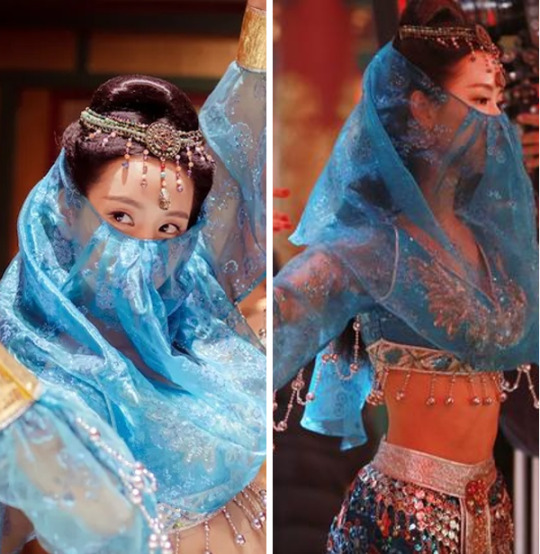
Bedlahs typically show up as dance costumes in historical Cdramas for the following reasons:
To give the dance a seductive/sensual air (of course this can be achieved with Chinese clothing, but bedlahs add an additional element of mystery and/or “exoticness”)
To suggest/signify Xiyu influence. Xiyu (西域), lit. “Western Regions”, was a historical name specified in the Chinese chronicles between the 3rd century BC to the 8th century AD that referred to the regions west of Yumen Pass, most often Central Asia or sometimes more specifically the easternmost portion of it (e.g. Altishahr or the Tarim Basin in southern Xinjiang), though it was sometimes used more generally to refer to other regions to the west of China as well, such as the Indian subcontinent (as in the novel Journey to the West)
For example, Tang dynasty-set Cdrama Beauties in the Closet features a bedlah dance scene, in which animal spirits disguised as women perform a dance to seduce the emperor (x). The Tang dynasty is famous for its Silk Road trade route that enabled strong relations with the empires to its west (ex: Byzantine, Persian, Arabian). The Tang capital Chang'an became an international metropolis, and foreign clothing & hairstyles became trendy. In Chang’an and Luoyang, Turkish and Persian fashions were highly sought after (x). Thus, the bedlahs in this scene serve to emphasize the seductiveness of the dance, as well as make a nod to the multicultural nature of Tang society:
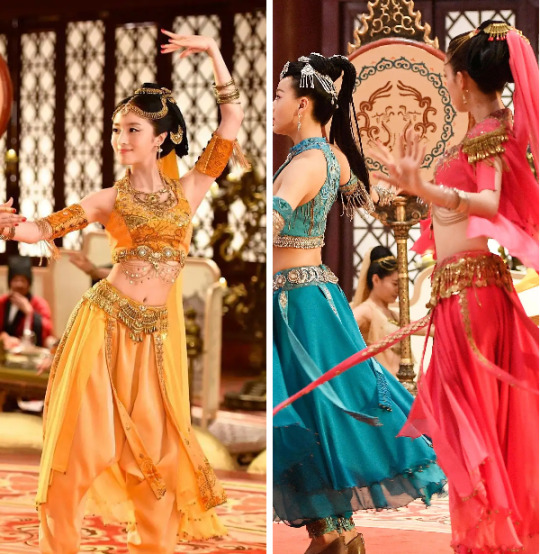
Another example comes from the historical Cdrama The Great Dunhuang, which is based on the history of the oasis city of Dunhuang, which lies on the ancient Silk Road. In this scene, Meiduo, a princess from the ancient Kingdom of Khotan, dances a feitian (apsara) dance in feitian costume (x). Feitian costumes as depicted in Chinese media have similarities with bedlah, as can be seen below:
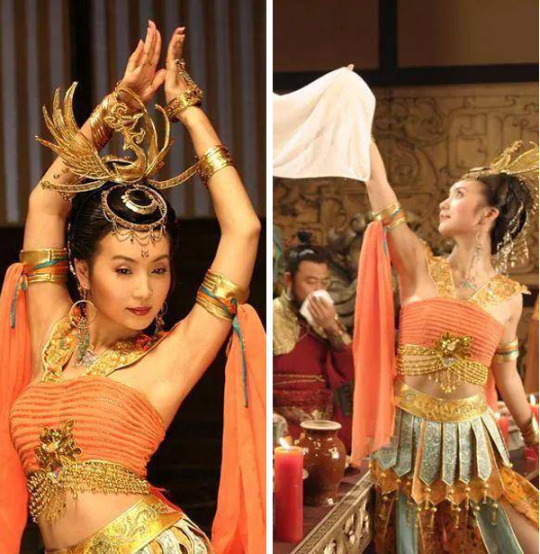
With all that said, though, the use of bedlahs in historical Cdrama costuming is still a modern aesthetic, due to the simple fact that the bedlah as we know it today is a modern 20th-century Egyptian belly dance costume influenced by European theatrical attire (1/2):
“The bedlah is essentially a Westernized creation, though not a wholly Western creation. What really cinched its iconic popularity in dance was the golden age of Egyptian Cinema in the 50s-70s, when Egyptian movies still largely cast professional dancers for dance roles. These Egyptian dancers, directors, and costumers sought inspiration from Hollywood and American culture - the bedlah is basically an Egyptianized iteration of the types of costuming that American dancers and showgirls were wearing. (Think Vegas, burlesque, cabaret, lounge and nightclub culture, in addition to movies/popular music culture.)” (Source)
Needless to say, this particular type of outfit did not even exist prior to the 1900s, much less during the Tang dynasty.
So why do they show up in historical Cdramas? As I’ve mentioned many times before (1/2/3), historical Chinese dramas tend to take a lot of liberties in their costume design. And indeed, this is one of those cases. I chalk it up to a combination of trying to appeal to modern audience’s aesthetics/expectations & lack of resources/attention. Researching & creating historically accurate outfits is a lot more difficult than slapping on a bedlah and calling it a day. ¯\_(ツ)_/¯
To be fair, this misunderstanding is a worldwide phenomenon, not just a Chinese one. For example, I don’t think it’s an exaggeration to say that Disney’s depiction of Princess Jasmine in a bedlah in Aladdin played a huge role in propagating the perception that the bedlah was an actual “ancient” historic outfit. This influence is especially noticeable in the recent Chinese “Xiyu aesthetic” fashion trend. Below are two Xiyu-style outfits with the theme “Loulan Princess” (the Loulan Kingdom was an ancient kingdom based around an important oasis city along the Silk Road) (x):

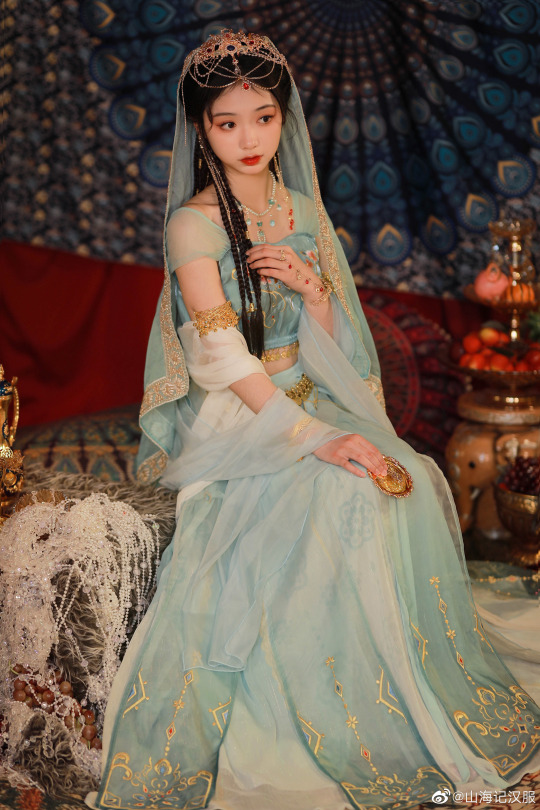
The “Princess Jasmine effect” is quite strong, wouldn’t you say? :P
For culturally/historically accurate Chinese dance clothes, please see my dance & dance hanfu tags.
If anyone wants to share more information, please do. Hope this helps!
376 notes
·
View notes
Note
I love reading ur thoughts about various podcasts. I'm trying to get into fiction podcasts, and I would like to ask what ur top 5 are. I'm listening to Eskew and really liking it.
Eskew is in fact my number one! It dragged me face first into sapient architecture, and I've never really left.
SAYER comes in number two for personal AI fucker reasons.
The Silt Verses probably count as number three, what with its complicated exploration of faith, abuse, and systems of oppression, but I feel guilty putting two podcasts by the same person on here for some reason. So instead I'm gonna say Olive Hill. It's a short one, limited run, set up as a fake true crime thing about two girls who went missing in a forest decades ago. And maybe I like it because it hits close to home, but as someone who grew up in a small town and has complicated feelings about that, Olive Hill is very important to me.
Fourth, Solutions to Problems. Mostly I talk about horror podcasts on here, but sometimes I just want to listen to a sci fi advice show based around some of the most goofy, ridiculous, fun shit out there. Jane and *screechy dolphin noise* answer questions from across the galaxy and also deal with their own messy personal lives. Jane has an off again on again thing with Melody, the station AI.
Fifth, in a return to form, The White Vault. Very good horror, I love horror that takes place somewhere extremely cold. It's just really cool. Also multicultural cast who speak multiple languages.
Honorable mentions, Wolf 359, which coulda gone harder with their villains, Welcome to Nightvale, which is the First Queer Podcast, and Dungeons and Daddies, which is an actual play dnd podcast instead of a strictly fictional one
12 notes
·
View notes
Text
Simone Ashley interviewed by New York Amsterdam News
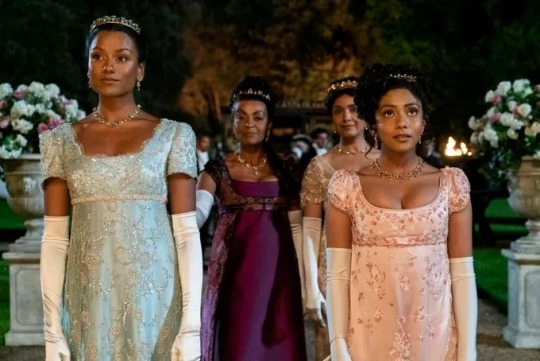
Simone Ashley in ‘Bridgerton’ Season 2—an actress to keep an eye on
by MARGRIA
April 14, 2022
There is no getting around how impacting “Bridgerton” Season 2 has been on the Black and Brown communities around the world. In America, where things are white and barely Black the arrival of two Indian characters, in key roles, in the second season, has set the social media world aflame, and rightly so.
And although the series is based on the book series written by Julia Quinn of which there are eight novels, one for each of the Bridgerton siblings, it was the visionary Shonda Rhimes (“Grey’s Anatomy,” “Scandal,”
“How to Get Away With Murder”) and her team that brought these characters to the small screen, making sure to cast gifted, multiracial actors. It’s a joy to watch. This attention to detail we can call the Rhimes touch because there are very few showrunners that have a better hit record than Rhimes, who has ruled television for most of the past two decades.
Now, to the facts. “Bridgerton” Season 2 is more than just a success story, it’s taken hold of the imagination of millions and has zoomed to the No. 1 spot in 76 countries, with a viewership of 82 million+ homes, and is moving, like a bullet, to becoming the second-most watched series by total watch time on the platform. This is just another example of Rhimes’ ability to create another cultural phenomenon while keeping her fingers firmly on the cultural zeitgeist and making sure that multiculturalism is never lost.
Although it’s not yet clear if the Netflix series will follow the same format as the books (or run eight seasons), Season 1 was mostly adapted from the first book in the series, “The Duke & I,” and the second, “The Viscount Who Loved Me.”
The love story in Season 2 focuses on Anthony Bridgerton (Jonathan Bailey) and Kate Sharma (Simone Ashley, Kate Sheffield in the book), who are both equally passionate and unmovingly stubborn in the show.
The sexual chemistry is clear for all to see, except the feuding lovers.
The second season finds Lord Bridgerton now determined to marry out of obligation, not love since he’s never recovered from witnessing the sudden death of his father (from a bee sting) at the age of 38.
The young Lord is taken for a spin when Edwina (Charithra Chandran)—the diamond of the season—will only marry the man approved by her older, deeply loved half-sister Kate. When Anthony begins to court Edwina, Kate’s defenses spring alive believing him to be a “rake, with a capital R” as a gossip columnist, Lady Whistledown, describes him in her popular scandal sheet. But it’s the undeniable chemistry between Anthony and Kate that makes this season so special.
Ashley has been a working actress for years, cutting her teeth in many well-known British dramas including “Doctors,” “Casualty,” “Broadchurch,” and “Guilt.” Then her career took a great jolt forwards when she landed a role in the Netflix smash hit, “Sex Education,” playing the hip, cool girl Olivia Hanan, a girl terrified to show her boyfriend her face during her sexual climax.
We caught up with Simone Ashley (Kate Sharma) to chat about her role in “Bridgerton” who is on record stating that representation “matters” (and, it does), and to discuss her character.
Amsterdam News: Congratulations on the success. They only gave me eight minutes which means three questions. Is there a question that you wished reporters had asked you, that they did not? She’s a complicated character.
Simon Ashley: Thank you. Well, I would like to speak more about my character [Kate Sharma] and there has been such a wonderfully warm response to having the Indian representation on this show. This character is inspired by author Julia Quinn, and she is such a nuanced, complex character and one that I enjoyed playing.
AmNews: You are an extremely gifted thespian and your body language is pure perfection. How did you work with the director?
SA: Thank you. I didn’t want to portray the character as a villain, someone who betrays her sister. This is about family, her love for her family. I wanted to portray a woman that’s authentic to her heart, and protecting Edwina, and her family. That’s the value that I wanted other women to see. I wanted to show that strength.
AmNews: Love is her motivation. It comes through very strongly.
SA: Kate is someone who wants to blend into the background. When we first meet her, her hair is in a bun, the make-up is minimal. She wears very dark colors. She isn’t very effervescent because she wants to put her sister first and in the spotlight. Kate, she’s the silent, kind of assigned type, in the background. She’s very observant.
AmNews: That’s an interesting way to describe her but accurate from what I viewed.
SA: She’s a people watcher, she loves to observe and I think she’s very reserved, and I think she’s not very open to being vulnerable with people. She likes to keep to herself.
AmNews: As I said, at the top of this conversation, she’s a very complicated character.
SA: I think that her journey is that she wants to run away from her problems. Her loss of her father, especially after she’s married off her sister. Then we slowly see her loosen up and become more colorful, with what she wears, and how she’s letting her hair fall. And she’s opening up to the idea of falling in love.
AmNews: Well said, and we do watch Kate fall in love—and the struggle of letting go is so wonderfully, delicious.
SA: I think, for me, it was important to tell that part of the story. She was in a rock and a hard place but she genuinely was falling in love with this person, Anthony, who is kind of her soulmate. And that journey of loving herself and setting herself free from those duties and responsibilities.
AmNews: Sounds like a fun challenge, am I correct?
SA: It was a fun challenge to play a character like that. Someone so subtle, with minimum speech in certain areas, and I enjoyed playing Kate, through her eyes, and her observations of this world that she’s in.
AmNews: Again, it goes back to my comment about your beautiful body language.
SA: Thank you. I am drawn to people like that anyway—mysterious—still waters run deep and that applies to Kate.
AmNews: Understatement, what I also loved, speaking about subtleties, is how Kate connected with the animals which included her dog, the horse, and a bee. A horse is a wild beast, you must pay attention.
SA: I resonated with Kate on this because she’s not like her sister, Edwina, a super academic, who practiced all the dances, Kate has an intuitive heart. She may not be as articulate as Edwina but she is very intuitive with animals which I applied with the bee sting scene, in episode 3, and when I was speaking with the director we discussed how she’s the only one that can calm Anthony down like she’s able to tame a wild horse. There is something about her in that ability to calm him because there is something animalistic about Anthony and Kate can handle that, she’s the only woman to put her foot on the ground [so, to speak] and hold the reins.
AmNews: Anthony is like that fairytale character, the one with the lion who is ailing because there is a splinter in his paw. He’s growling because he’s in pain.
SA: Yes. I love that analogy. Exactly. She’s very brave for both of them.
AmNews: Let’s talk about the look—the no beauty look created by makeup artist Pat McGrath.
SA: All hail to [makeup artist] Pat McGrath, she’s one of the loveliest people that I’ve ever met. Her beauty products are just incredible and we used her products on the show. I was more than happy, I was incredibly honored to wear the products. And when I walked on the set, I felt so beautiful, and confident, like a princess, and that my skin was being shown off in the best way possible and that’s something rare.
AmNews: You said a mouthful. To get our colors correct, on-screen—it’s close to being a miracle.
SA: It’s beautiful how it brings dark skin to life with the lighting, and the makeup—everything.
AmNews: You did not look like a zombie.
SA: Exactly, no gray tones on this set.
AmNews: Not with Ms. Pat McGrath.
#simone ashley#kate sharma#bridgerton#bridgerton netfix#kate sheffield#bridgerton cast#olivia hanan#new york amsterdam news#interview
40 notes
·
View notes